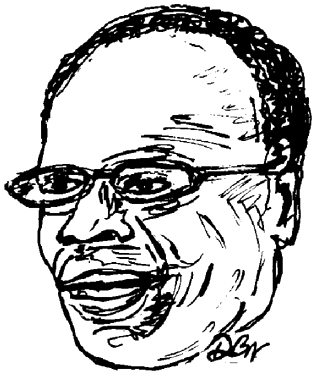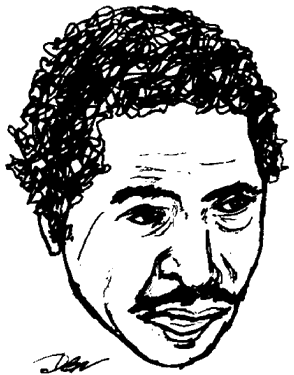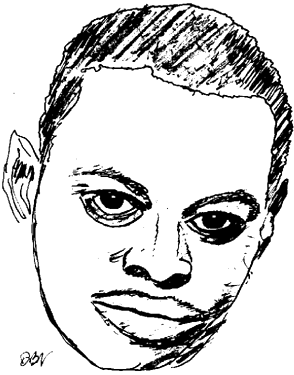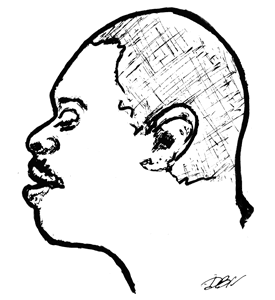Read A Book: DBN On David Whiteis
June 1, 2024:
FROM THE ARCHIVES:
Pictured: Sir Charles Jones
August 11, 2013: THE FIRST BOOK ABOUT CONTEMPORARY SOUTHERN SOUL APPEARS
DADDY B. NICE REFLECTS ON SOUTHERN SOUL-BLUES BY DAVID WHITEIS
Here are the kinds of things you'll learn if you get David Whiteis' new book,
SOUTHERN SOUL-BLUES, available at Amazon, Barnes & Noble and other retailers by clicking the link:
When Chicagoan Emmett Garner attempted to break
Stan Mosley into the Chicago radio market, he was blindsided by questions of Mosley's age.
 "How old is he?" First thing they ask. They didn't ask me how good he was or what he got going. "How old is he?" Girl (at a radio station) told me, "I seen (Stan Mosley's) record, but I saw it was on Malaco. I didn't even listen to it. I put it to the side."
"How old is he?" First thing they ask. They didn't ask me how good he was or what he got going. "How old is he?" Girl (at a radio station) told me, "I seen (Stan Mosley's) record, but I saw it was on Malaco. I didn't even listen to it. I put it to the side."
*****
Denise LaSalle is a writer. And no, I do not mean only a songwriter. Denise is a literary writer. Author David Whiteis asked her for permission to use her prose poem, "America's Prodigal Son," as the foreword to the book. In the poem LaSalle makes the blues a character and inhabits the character in the first person. Here's a taste:
 I was born in the United States of America, a product of slavery in the Deep South. My mother's name is Heartache; my father's name is Pain.
I was born in the United States of America, a product of slavery in the Deep South. My mother's name is Heartache; my father's name is Pain.
I was a sad and lonely child. My only sister, Gospel, was very religious and thought she was better than I. So, we traveled in different circles....
*****
Contemporary Southern Soul music, reviled in some quarters for its R- and X-rated lyrics, did not invent "raunch":
Blind Lemon Jefferson's nightmarishly phallic "That Black Snake Moan" in 1926 was one of the earliest blues hits. "Classic blues" women such as Bessie Smith, Ma Rainey, and Lil Johnson, to name just a few, recorded sexually unexpurgated songs that violated their eras' taboos. Hattie Hart and the Memphis Jug Band invoked oral sex in "Memphis Yo-Yo Blues" in 1929 ("Bring your yoyo, wrap the string around my tongue"); so did Peetie Wheatstraw in his sacrilegiously titled "The First Shall Be Last and the Last Shall Be First" seven years later ("The first woman I had, she made me get on my knees/ and had the nerve to ask me....did I like Limbuger cheese"). Tampa Red (accompanied on his early sides by pianist Georgia Tom Dorsey, who went on to become the founding father of modern gospel) recorded such titles as "It's Tight Like That," "The Duck's Yas-Yas-Yas," and "Let Me Play With Your Poodle" between the late 1920's and the early 1940's. And when Howlin' Wolf bragged about the exploits of his "little red rooster" in 1961, few could have missed the fact that his "rooster" was nothing more (or less) than a "cock."
*****
Despite the denials of northern whites, the North was no stranger to the racial hostilities common to the Deep South:
"It makes me more angry now than it did then," (Bobby Rush) asserts. "At that time, see, that was common to me as a black man. Even up North. Oh yeah. Oh, God, yeah. Even up North.

"I believe it was a place called Apex, in (suburban) Robbins, Illinois. About 1952. Black ladies would come there on a Wednesday and a Thursday; white guys would come to mingle and deal with the black ladies. We played in this place on weekends. All-white audience. They wanted to hear the black music, but they didn't wan' to see our face. They had a curtain. Once a night I could take a bow; when they opened the curtain, they said, 'Ladies and gentleman, you've been (entertained) by Bobby Rush,' and they open it up, I take a bow, and--foo! They close it up. Just like that."
*****
Most fans have assumed Sir Charles Jones was born in Alabama, where he grew up, and Charles has never been especially forthcoming about his early years, so it may come as a surprise to hear that Charles was born "up north," in the same state that would later produce Bigg Robb:
 I was born on April 25, 1973 in Summit County Hospital in Akron, Ohio. My father was a piano player and a writer and a lead gospel singer, come from a famous group from Akron, Ohio called the Christian All-Stars. My mom, Blanche Jones, had an old piano inside of the house, and she would notice how I could piece notes together, being about six years old, and she was shocked at how perfect of pitch my ears were. I could actually keep a note and sing to the rhythm of the piano--"Mary Had A Little Lamb," and stuff like that. My father started sitting down and teaching me a few chords, a lot of gospel hymns. The hymns and a lot of the scales and stuff that he taught me on the piano, I really kind of just picked it up by ear, on my own; I played it by ear.
I was born on April 25, 1973 in Summit County Hospital in Akron, Ohio. My father was a piano player and a writer and a lead gospel singer, come from a famous group from Akron, Ohio called the Christian All-Stars. My mom, Blanche Jones, had an old piano inside of the house, and she would notice how I could piece notes together, being about six years old, and she was shocked at how perfect of pitch my ears were. I could actually keep a note and sing to the rhythm of the piano--"Mary Had A Little Lamb," and stuff like that. My father started sitting down and teaching me a few chords, a lot of gospel hymns. The hymns and a lot of the scales and stuff that he taught me on the piano, I really kind of just picked it up by ear, on my own; I played it by ear.
*****
And from the author David Whiteis himself:
(Southern Soul-Blues) is still primarily a singer's showcase: vocals are usually mixed well out in front, they tend to be relatively straightforward and devoid of flowery melisma, and they're seldom distorted or tweaked electronically. Guitar and sax solos remain prevalent, even if the rest of the accompaniment is almost entirely synthesized... And for all the complaints about "raunchy" lyrics, the subject matter is usually mild by contemporary standards, and plenty of songs still praise "country" virtues like faith, family, and perseverance through hard times.
Probably for these reasons, the music continues to attract a fan base somewhat older and more socially conservative, probably more solidly working-class, and more defined by region than the mainstream R&B listenership (although the two audiences definitely overlap). It's a sizable demographic and southern soul can't afford to lose it, but to remain viable in today's marketplace, it needs to appeal to younger, trendier, and more shopping-savvy listeners as well as the old-school vanguard that makes up its primary base. The conflicting desire to go "mainstream" while remaining true to stylistic and regional roots... remains one of southern soul's most significant challenges.
*****
After struggling over the years to put the ephemera of music into a vocabulary readers can understand, your Daddy B. Nice can attest to the mental sophistication behind Whiteis' seemingly casual summary, and the same specificity, depth and scope characterize the book as a whole.
An impressive (and long overdue) summation of the contemporary southern soul scene aimed at the generally uninitiated flows into profiles of four older-generation artists--Latimore, Denise LaSalle, Bobby Rush and J. Blackfoot (who died before the book was published)--all considered in loving detail.
Whiteis then showcases four "mid-to-younger"-generation performers. (The eldest, Willie Clayton, could just as well have been placed in the first group of "soul survivors.") The other three are Sir Charles Jones, Ms. Jody and Sweet Angel. The book concludes with peremptory cameos of additional artists, songwriters, and issues, most prominently the debate about X-rated material.
(Whiteis wisely avoids controversies over nomenclature, using "southern soul," "soul-blues," and "southern soul-blues" interchangeably.)

The profiles form the "meat" of the book, and without exception they make for fascinating reading. The chapter on Latimore, for example, in addition to painting a picture of both the ordinary man at home and the consummate career performer, makes clear the sensitivity and enhanced level of sophistication of the man, and--by extension--all Southern Soul performers. The vignettes on Bobby Rush add yet another wrinkle to the complex "trickster" evoked by Martin Scorcese in his documentary on the blues.
Whiteis isn't entirely free of the lofty generalizations and social-science jargon of academia (see the final sentence of his chapter on "The Raunch Debate), and his explanations of the differences between the blues and various kinds of historical soul (r&b, deep, southern, etc.) are too convoluted for the casual reader (and, I confess, me) to appreciate. But these are minor flaws in a work that succeeds brilliantly in placing contemporary southern soul in its historical context. Only a few people--and maybe only Whiteis himself--could have written this book.
First, you have to be a voracious consumer of the accumulated information, and in that respect Whiteis stands on the shoulders of yours truly (Daddy B. Nice) and Blues Critic (Dylann DeAnna), whom he dutifully credits. Then you're talking about absorbing a huge amount of music that only a minority of blues aficionados even knows exists.
Whiteis also relies on apparently extensive feedback from Malaco Records' Tommy Couch Jr., who repeatedly derides "the lick-it and stick-it" aspect of the music and laments Southern Soul's "demise". Despite coming off at times as "carping," Couch is a pivotal character in the book, having (along with his father, Tommy Couch Sr.) marshaled contemporary southern soul through roughly its first fifteen years) and even with a reduced profile he remains a key figure and source.
In short, Whiteis has done his homework. He hasn't been afraid to ask questions of any of us in Southern Soul--performers or media--and he flexes a correspondingly genuine feel for the songs, the artists and even the themes.

(I was shocked and happily surprised to run across his appreciative citation of an obscure song I have long touted: Lee Fields' "I'll Put My Life On The Line.")
However, Whiteis brings additional credentials. He's a historian of the blues (with a prior published book),
Chicago Blues: Portraits and Stories (Music in American Life), and he brings an historical perspective and a researcher's discipline to the subject.
The text is broken every few pages with black-and-white photographs of the core artists. Add the detailed background interviews Whiteis negotiated with each of the featured artists and you have an idea of the book's cumulative impact.
The result is another big step forward for Southern Soul in its bid for wider acceptance--the caveat being that even big steps can seem like "baby" steps in the world of Southern Soul music. In an otherwise objective if diminutive review of SOUTHERN SOUL-BLUES,
Kirkus Reviews noted that:
Major U.S. labels and big-market R&B radio have never given the style a tumble, and its artists must be content with selling their material either through smaller independents or via their own imprints. While Whiteis holds out some hope that soul-blues can sustain itself in the wide-open world of Internet music distribution, he offers no compelling evidence that this is actually a path out of the wilderness. And his maddening reluctance to offer album sales or radio-airplay figures only confirms the reader's suspicion that this is an increasingly marginal music that is playing to a graying, shrinking and narrowly circumscribed audience.
The Kirkus reviewer makes it sound like Southern Soul is in its death throes when in fact the number of artists and CD's keeps growing, and the small concert and festival scene is more vibrant than perhaps any other genre or sub-genre in the country.
See Daddy B. Nice's Concert Calendar.
Kirkus holds Whiteis's feet to the fire for his "maddening reluctance to offer album sales or radio-airplay figures" even though Whiteis specifically addresses "defining a hit in the soul-blues market" with Ecko Records' John Ward:
"I really don't know what would constitute a "hit" in terms of sales nowadays," admits John Ward. "Nobody is really selling much more than three thousand copies of anything now."
That's pretty specific.
What's puzzling if not "maddening" is that an entire generation of white blues artists and blues fans worship at the altar of Leadbelly and Muddy Waters and Howlin' Wolf and J. B. Lenoir as if the music had petrified into a sacrament while the "living" music percolates underground, waiting to be discovered in similar beatifying fashion a quarter-century from now by their grandsons or daughters, who will by then theoretically have enough "distance" to savor the carnality and sensuality we "southern soul insiders" are already enjoying today.
My only other quibble with
SOUTHERN SOUL-BLUES is that Whiteis didn't go down to Louisiana and interview the Neal family and do a much-needed chapter on Jackie Neal, a far more influential figure than, say, Sweet Angel (who to HER credit was also featured in a "Village Voice" article on Southern Soul a couple of years back).
To his credit, Whiteis uses the chapters on Ms. Jody and Sweet Angel to illustrate the flamboyantly risque humor of southern soul's stage acts, male or female. But there are other topics he doesn't explore, like the glorification of "big" women in the culture, or the almost atavistic male "dominance" over women which directly or indirectly led to Jackie Neal's death. Jackie Neal, who posed nude doggy-style on her first album cover, was no stranger to X-rated showmanship, but her music, life and death call up deeper questions about a woman's role in southern soul music and culture.
Finally, it's August of 2013 and I do believe I just saw two new singles put out by Tommy Couch Jr.'s Malaco Records. That's right: it wasn't even Waldoxy (a subsidiary of Malaco); they were on the Malaco label. Could it be? Another sign of life? Green buds in this burned-out old planet of the blues?
--Daddy B. Nice
BUY SOUTHERN SOUL-BLUES by DAVID WHITEIS.
**************

Corrections, comments, information or questions for Daddy B. Nice?
Write to
daddybnice@southernsoulrnb.com
*************
--Daddy B. Nice








 (I was shocked and happily surprised to run across his appreciative citation of an obscure song I have long touted: Lee Fields' "I'll Put My Life On The Line.")
(I was shocked and happily surprised to run across his appreciative citation of an obscure song I have long touted: Lee Fields' "I'll Put My Life On The Line.")

